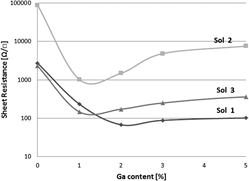Crossref Citations
This article has been cited by the following publications. This list is generated based on data provided by
Crossref.
Srivastava, Amit Kumar
and
Kumar, Jitendra
2013.
Effect of zinc addition and vacuum annealing time on the properties of spin-coated low-cost transparent conducting 1 at% Ga–ZnO thin films.
Science and Technology of Advanced Materials,
Vol. 14,
Issue. 6,
p.
065002.
Kwon, Jeong Moo
Jung, Joohye
Rim, You Seung
Kim, Dong Lim
and
Kim, Hyun Jae
2014.
Improvement in Negative Bias Stress Stability of Solution-Processed Amorphous In–Ga–Zn–O Thin-Film Transistors Using Hydrogen Peroxide.
ACS Applied Materials & Interfaces,
Vol. 6,
Issue. 5,
p.
3371.
Bu, Ian Y.Y.
2014.
Effects of the pre-annealing temperature on structural and optical properties of sol–gel deposited aluminium doped zinc oxide.
Ceramics International,
Vol. 40,
Issue. 8,
p.
11941.
Bhoomanee, Chawalit
Nilphai, Sanpet
Sutthana, Sutthipoj
Ruankham, Pipat
Choopun, Supab
and
Wongratanaphisan, Duangmanee
2015.
Effect of Gallium Interlayer in ZnO and Al-doped ZnO Thin Films.
Integrated Ferroelectrics,
Vol. 165,
Issue. 1,
p.
121.
Ayana, Dawit G.
Prusakova, Valentina
Ceccato, Riccardo
and
Dire, Sandra
2015.
Structural characterization of sol-gel ZnO thin films on different substrates for memristive application.
p.
1.
Kim, Donghyun
Ha, Jaeheung
Park, Jongjang
Hwang, Jun
Jeon, Heonsu
Lee, Changhee
and
Hong, Yongtaek
2016.
Enhanced light outcoupling of polymer light-emitting diodes with a solution-processed, -flattening photonic-crystal underlayer.
Journal of Information Display,
Vol. 17,
Issue. 4,
p.
143.
John, Rohit Abraham
Nguyen, Anh Chien
Chen, Yuxin
Shukla, Sudhanshu
Chen, Shi
and
Mathews, Nripan
2016.
Modulating Cationic Ratios for High-Performance Transparent Solution-Processed Electronics.
ACS Applied Materials & Interfaces,
Vol. 8,
Issue. 2,
p.
1139.
Muchuweni, E.
Sathiaraj, T.S.
and
Nyakotyo, H.
2016.
Physical properties of gallium and aluminium co-doped zinc oxide thin films deposited at different radio frequency magnetron sputtering power.
Ceramics International,
Vol. 42,
Issue. 15,
p.
17706.
Muchuweni, E.
Sathiaraj, T.S.
and
Nyakotyo, H.
2016.
Low temperature synthesis of radio frequency magnetron sputtered gallium and aluminium co-doped zinc oxide thin films for transparent electrode fabrication.
Applied Surface Science,
Vol. 390,
Issue. ,
p.
570.
Makuku, O.
Mbaiwa, F.
and
Sathiaraj, T.S.
2016.
Structural, optical and electrical properties of low temperature grown undoped and (Al, Ga) co-doped ZnO thin films by spray pyrolysis.
Ceramics International,
Vol. 42,
Issue. 13,
p.
14581.
Ayana, Dawit Gemechu
Ceccato, Riccardo
Collini, Cristian
Lorenzelli, Leandro
Prusakova, Valentina
and
Dirè, Sandra
2016.
Sol-gel derived oriented multilayer ZnO thin films with memristive response.
Thin Solid Films,
Vol. 615,
Issue. ,
p.
427.
Muchuweni, E.
Sathiaraj, T.S.
and
Nyakotyo, H.
2016.
Effect of gallium doping on the structural, optical and electrical properties of zinc oxide thin films prepared by spray pyrolysis.
Ceramics International,
Vol. 42,
Issue. 8,
p.
10066.
Muchuweni, E.
Sathiaraj, T.S.
and
Nyakotyo, H.
2017.
Synthesis and characterization of zinc oxide thin films for optoelectronic applications.
Heliyon,
Vol. 3,
Issue. 4,
p.
e00285.
Asikuzun, E.
Ozturk, O.
Arda, L.
and
Terzioglu, C.
2017.
Microstructural and electrical characterizations of transparent Er-doped ZnO nano thin films prepared by sol–gel process.
Journal of Materials Science: Materials in Electronics,
Vol. 28,
Issue. 19,
p.
14314.
Muchuweni, E.
Sathiaraj, T.S.
and
Nyakotyo, H.
2017.
Hydrothermal synthesis of ZnO nanowires on rf sputtered Ga and Al co-doped ZnO thin films for solar cell application.
Journal of Alloys and Compounds,
Vol. 721,
Issue. ,
p.
45.
Boussatha, Nadia
Gilliot, Mickaël
Ghoualem, Hafida
and
Martin, Jérôme
2018.
Formation of nanogranular ZnO ultrathin films and estimation of their performance for photocatalytic degradation of amoxicillin antibiotic.
Materials Research Bulletin,
Vol. 99,
Issue. ,
p.
485.
Ivanova, T.
Harizanova, A.
Koutzarova, T.
Vertruyen, B.
and
Stefanov, B.
2018.
Structural and morphological characterization of sol-gel ZnO:Ga films: Effect of annealing temperatures.
Thin Solid Films,
Vol. 646,
Issue. ,
p.
132.
Crockett, Brandon M.
Jansons, Adam W.
Koskela, Kristopher M.
Sharps, Meredith C.
Johnson, Darren W.
and
Hutchison, James E.
2019.
Influence of Nanocrystal Size on the Optoelectronic Properties of Thin, Solution-Cast Sn-Doped In2O3 Films.
Chemistry of Materials,
Vol. 31,
Issue. 9,
p.
3370.
Dinmohammadi, M.
Ghodsi, F. E.
and
Mazloom, J.
2019.
Effect of chelating agents on the surface parameters and optical constant of CZO thin films by sol–gel process.
Journal of Materials Science: Materials in Electronics,
Vol. 30,
Issue. 6,
p.
5947.
Aggarwal, Nupur
Vasishth, Ajay
Kaur, Kamaldeep
and
Verma, N. K.
2019.
Role of Dysprosium Doping on Structural, Optical, Magnetic and Electrical Properties of ZnO Nanorods.
Journal of Superconductivity and Novel Magnetism,
Vol. 32,
Issue. 3,
p.
685.
